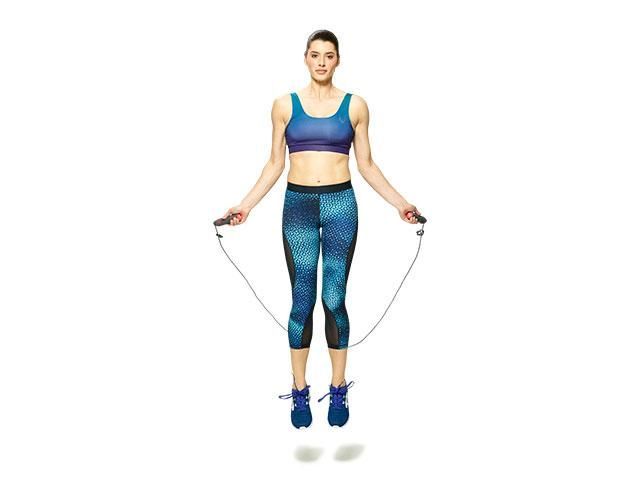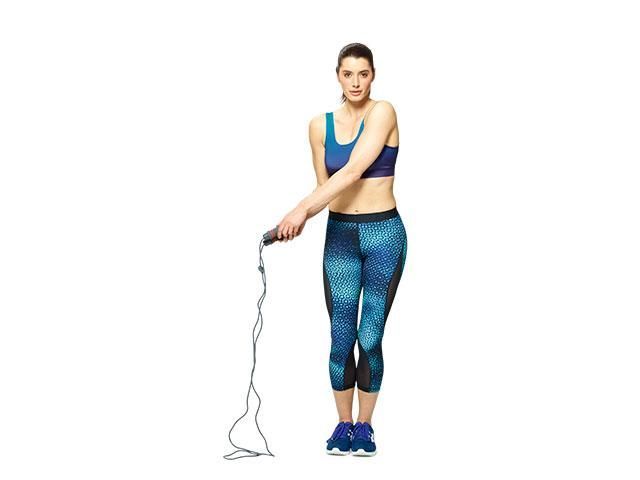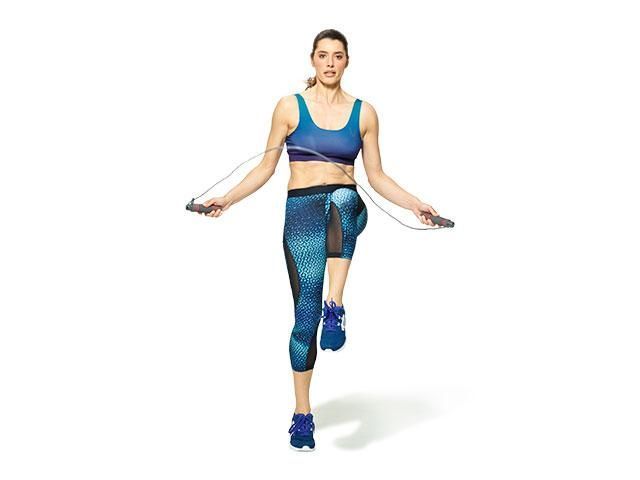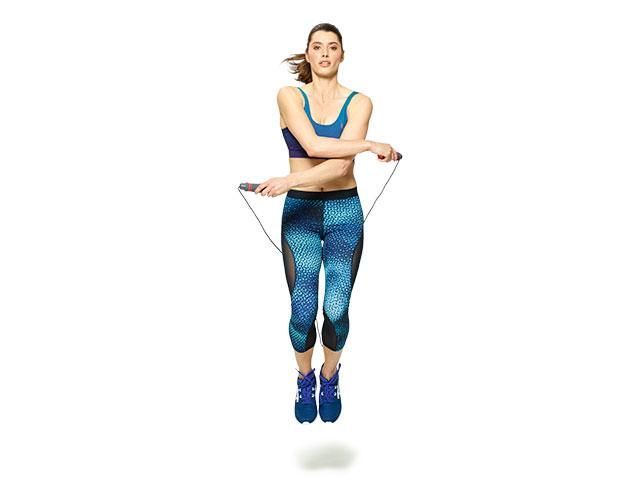The benefits of skipping abound. For starters, you can bag a rope for less than your daily coffee; secondly, they’re so easy to use; skipping works wonders for your health; and last but by no means least, you can take and use a skipping rope (either a standard or weighted skipping rope literally anywhere) – or nowhere, if you’d rather stay home.
It’s for this reason that every man and his dog seemed to take up skipping during each national lockdown, and it’s also why we haven’t stopped since. From skipping benefits to how to skip rope and the best skipping workouts, here’s everything you need to know. No skipping.
10 benefits of skipping
Is skipping good for you, you ask? ‘Skipping is a fantastic method for training power, speed and endurance, with key benefits for ankle, pelvic and knee stability,’ says Corinne Naomi, an instructor at FIIT. This is why skipping is a popular feature in CrossFit WODs (mastering double-unders, where you spin the rope around twice per jump, is a badge of honour) and has long been a fave among boxers looking to boost balance, coordination and overall fitness – way before the hipsters started to catch on. Here are the specifics.
1.Skipping is efficient
Fancy footwork aside, skipping exercise is one of the most efficient out there; a study in Research Quarterly For Exercise And Sport found that skipping for 10 minutes a day delivered the same benefits over six weeks as jogging daily for 30 minutes. Our kinda cardio workout. Add in intervals – so, go as fast as you can for a set amount of time, then slow down for a certain period, before repeating – and skipping can also make for a seriously effective HIIT workout.
2. Skipping is a full-body workout
One of the biggest skipping benefits is that it’s a total-body workout, incorporating your arms and shoulders as much as it does your legs. It also gives poor posture a helping hand by encouraging you to pull your shoulders back and out of the hunched posture in which you probably spend most of your day.
3. Skipping can strengthen your bones
In one study, women who jumped on the spot three times a week for six months increased their lower-body bone density, getting the jump on osteoporosis in the process.
4. Skipping is mentally challenging
The only thing standing between you and skipping success is, well, you. Because it’s tricky to navigate an efficient and effective warm-up or workout when you’ve psyched yourself out so much that you trip over every two seconds or whip your shins like a religious flagellant. Stick with it. ‘As tedious as it sounds, it’s all down to practice,’ says Christa DiPaolo, creator of Equinox’s The Cut: Jump Rope class. ‘You can always grip both handles in one hand and swing the rope on one side while you practise your basic bounce. This will help you get comfortable before actually skipping,’ she suggests.
5. Skipping is for everyone
While your skipping technique can be mentally challenging, once you’ve got to grips with it, it really is for everyone. You can adapt the workouts to suit all abilities, simply by changing your pace (i.e. how fast you skip), and the duration of your skipping sessions.
Somewhat counterintuitively, weighted skipping ropes that engage more muscles can also make skipping easier for beginners. ‘It naturally slows down the rotation, which will set you up for success with a lighter speed rope,’ adds DiPaolo. Then, once you’ve learnt the technique, a heavier one will scale up the demands on your body – and bring your results on leaps and bounds.
6. Skipping improves your coordination
According to a study in the Journal of Sports Science & Medicine, those of us who regularly skip will likely have better motor coordination and balance than those who don’t. If you’ve tried skipping before, this won’t be hard to understand: knowing where to put your feet and when in order to avoid tripping over your rope isn’t as easy as it sounds. Your knees, hips and ankles all work in conjunction with one another.
7. Skipping will keep your heart healthy
Plenty of research has proven that skipping can help lower your blood pressure. In a 2019 study on young men, where one group skipped twice a day for 12 weeks and the other group followed their usual exercise routine, the skipping group showed significant improvements in their VO2 max (i.e. how much oxygen the body uses during exercise – those who skipped used considerably less).
Another 2019 study in the European Journal of Applied Physiology showed that skipping can have a positive effect on other factors associated with cardiovascular disease, such as your body composition, inflammation in your body, blood pressure and vascular function (how blood and lymph circulates throughout the body).
8. Skipping can help you improve your running speed
Yep, really. A meta-analysis of 21 studies found a link between skipping and faster running times, when it comes to runs between 2-5k. The participants who skipped showed impressive improvements in jump performance, sprint performance, reactive strength (how high an athlete jumps after landing) and running economy (how efficiently your body copes with running, based on various metrics such as cardiorespiratory and metabolic rate).
More research published in the International Journal of Sports Physiology and Performance found that incorporating skipping in your running warm-ups (specifically, 10-20 minutes, two-four times a week) could help you improve your 3k PB run time.
9. Skipping could ease anxiety
It’s no surprise that exercise eases anxiety (big up the endorphins), but studies show that skipping could be especially beneficial. In a 2021 study, a divided group of volunteers were asked to skip for seven sessions of two minutes—followed by one minute of rest. The results showed that the participants who skipped showed significant reductions in anxiety scores, as well as a higher attention span and cognitive function. The skippers also showed higher levels of 5–hydroxyindoleacetic acid in their urine, which indicates a rise in serotonin (the beloved happy hormone).
How does this work? In a nutshell, when your muscles contract during skipping, certain amino acids are recruited to make your muscles do their job; these amino acids compete with tryptophan (the precursor of serotonin) to enter your brain, so when they are off busy helping your muscles, more of your tryptophan can slip past into your brain, which causes an increase in serotonin.
10. Skipping is cheap
Skipping can be done anywhere, so long as you have room for the rope to pass your head. All you need is a skipping rope, most of which you can bag for under £5. Scroll up for our pick of the best.
Skipping form tips
Don’t skip these form tips from Equinox’s Christa DiPaolo and you’ll be top of the class.
- Stay low to the ground, knees soft, and stay light on your feet to minimise impact
- Your arms should be at a 45-degree angle and pulled into your ribs.
- Rotate from your wrists rather than the shoulders
- If you’re using a heavier rope, rotate with your forearms
- Keep your core engaged throughout. Heavier ropes force you to do so.
How to skip rope
These five moves range from classic to kinda super hard. Get to grips with the classic skip first before moving on, but make sure you try to level up when you’re ready. It’ll help keep your mind engaged and improve hand-eye coordination.
Beginner: Classic skip
Targets: Calves, hamstrings
a. So, engage your core and swing the rope over your head. But this time, jump over it with both feet instead of hopping. In other words, your classic skip (the clue’s in the name).
b. Steadily increase the speed at which the rope swings, then, when your heart is pumping, add in a second jump as it passes over your head. Now, catch your breath.
Beginner: Hopping skip
Targets: Calves, hamstrings
a. Engage your core and hold a handle of the rope in each hand. Keep your hands out to the side, elbows tucked in. Swing the rope above your head and hop over it on your right foot.
b. With each arc of the rope, switch feet so you land on a different foot each time.
Intermediate: Side-to-side skip
Targets: Biceps, triceps
a. Holding the rope, begin with your hands together at one side of your body. Moving your hands in a figure of eight motion across your torso, swing the rope so that the midpoint reaches above your head before hitting the floor at the opposite side of your body. Repeat this motion four times.
b. On the fifth swing, separate your hands so they are at each side of your body in classic skipping position, skip over the rope, then return to the start and repeat. Don’t forget that core.
Intermediate: High knees
Targets: Calves, hamstrings, glutes
a. Start with hands either side of your body ready to swing the rope over your head. Now, instead of jumping over the rope, alternate high knee hops. Yep, it hurts.
Hard: Crossover skip
Targets: Deltoids, chest
a. Start in the classic skipping position with your core engaged. Begin to do your first skip, but, as the rope swings above your head, cross your hands over your torso.
b. As you do your second skip, uncross your arms to return to the classic position. Then do it all over again, alternating with each jump.
Best skipping rope workouts
To reap the bulk of the best skipping benefits, start by doing two or three of the below sessions a week. Then build up to five weekly sessions as your technique improves. Once you feel like you’ve mastered the skipping staples, give these skipping workouts a go.
Workout one
Complete the circuit 3 times using a standard skipping rope, resting for one minute between circuits.
1. Basic bounce 1 minute: (Jump with both feet together)
2. Walk-out press-ups 30 seconds: (Bend at the hips, walk hands out to a high plank and do a press-up, then walk back to squat)
3. Skiers 2 minutes: (Jump side to side, feet together)
4. Walk-out press-ups 30 seconds
5. Forward and back skiers 2 minutes
6. Burnout 1min: (Jump the rope as fast as you can. It’s simple, but it’s a killer)
Workout two
Complete this more demanding circuit three times with a heavier rope, resting for one minute between circuits.
1. Basic bounce 1 minute
2. Fighting burpees 30 seconds: (Do a single burpee with a press-up and jump, then finish with four straight punches)
3. Side straddle 2 minutes: (Jump feet hip-width apart and in)
4. Fighting burpees 30 seconds
5. Forward and back skiers 2 minutes
6. Burnout 1min
11 online skipping workouts to try yourself
The gym workout is on hold and you’re ready to carve some time out for a sweaty skipping workout? Look no further. We’ve found the best skipping workouts from five to 60 minutes to swing your rope to.
1. 5-minute beginner skipping workout
Short, sharp, effective, this workout takes less time than downing your morning brew. Perfect for beginners, tag this onto the beginning or end of your workout and watch your form improve.
2. 10-minute beginner skipping workout
Make it longer with a ten-minute workout from the same jump roping dudes. They recommend using a 1lb skipping rope which is about 453 grams, but whatever you have at home (that’s not too heavy) is fine.
3. 10-minute jump rope routine
This ten-minute class features different skipping styles – from the double jump to side-to-side skips – which makes it perfect for those who are already familiar with skipping and want to try a new routine.
4. 10-minute skipping HIIT workout
A medley of skipping and HIIT exercises, join trainer Simeon for some serious sweat. Expect mountain climbers, high knees and jumping jacks, interspersed with bursts of skipping. Phew.
5. 15-minute cardio skipping workout
PT Sydney switches things up with a workout that uses the rope to skip but also to get some cardio moves in too. One of them, you hop from side to side over the rope on the ground. It’s fun, different and fast. Everything we love.
6. 20-minute jump rope HIIT workout
Slightly longer now (perfect for a lunch break or post-work session), this workout is easy to follow and perfect if you prefer sessions without much talking. Follow Rachel’s lead and listen out for the beeps to know when to change exercise.
7. 30-minute full-body skipping workout with Krissy Cela
Krissy designed this skipping workout exclusively for WH, switching between bodyweight exercises and skipping for the ultimate sweaty HIIT workout at home.
8. 30-minute full body HIIT skipping workout
Heather Robertson is one of YouTube’s most beloved trainers (1.3m subscribers, say what!) and her skipping workout is one not to be missed. Good to note that you’ll also need dumbbells for this full-body session.
9. 45-minute glutes and jump rope workout
Have three-quarters of an hour to spare? Sydney’s glute and skipping workout will build lower body muscle and improve your muscular endurance, too. This means you’ll sculpt and tone your lower body while also getting stronger too. We love.
10. 50-minute jump rope HIIT workout
A challenging workout (and not one we’d recommend for beginners), this workout cycles through 19 exercises, three times over. You’ll work for 30 seconds with 15 seconds rest each time. Sweatin’ hell.
11. 60-minute skipping workout
One of the hardest skipping workouts we’ve seen, you’ll switch between 60-seconds of bodyweight exercise and 60-seconds of skipping. Hard? You betcha. If you can’t complete the entire workout, no stress. Do as much as you can and take rests as needed.















